| Listing 1 - 10 of 25 | << page >> |
Sort by
|
Book
ISBN: 0199895554 9780199895557 Year: 2012 Publisher: New York : Oxford University Press, USA,
Abstract | Keywords | Export | Availability | Bookmark
 Loading...
Loading...Choose an application
- Reference Manager
- EndNote
- RefWorks (Direct export to RefWorks)
Book
ISBN: 9789575987107 9575987101 Year: 2016 Publisher: Taibei Shi : Fa gu wen hua,
Abstract | Keywords | Export | Availability | Bookmark
 Loading...
Loading...Choose an application
- Reference Manager
- EndNote
- RefWorks (Direct export to RefWorks)
Book
ISBN: 344702674X Year: 1987 Publisher: Wiesbaden : Harrassowitz,
Abstract | Keywords | Export | Availability | Bookmark
 Loading...
Loading...Choose an application
- Reference Manager
- EndNote
- RefWorks (Direct export to RefWorks)
Death --- Intermediate state --- Religious aspects --- Buddhism. --- Buddhism. --- Karma-gliṅ-pa,
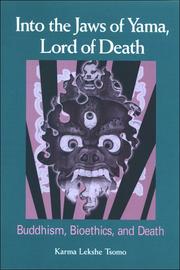
ISBN: 079148145X 1429411902 9781429411905 0791468313 0791468321 9780791468319 9780791468326 9780791481455 Year: 2006 Publisher: Albany State University of New York Press
Abstract | Keywords | Export | Availability | Bookmark
 Loading...
Loading...Choose an application
- Reference Manager
- EndNote
- RefWorks (Direct export to RefWorks)
"This book explores the Buddhist view of death and its implications for contemporary bioethics. Writing primarily from within the Tibetan tradition, author Karma Lekshe Tsomo discusses Buddhist notions of human consciousness and personal identity and how these figure in the Buddhist view of death. Beliefs about death and enlightenment and states between life and death are also discussed. Tsomo goes on to examine such hot-button topics as cloning, abortion, assisted suicide, euthanasia, organ donation, genetic engineering, and stem-cell research within a Buddhist context, introducing new ways of thinking about these highly controversial issues."--Jacket
Buddhism --- Intermediate state --- Death --- Buddhist doctrines --- Buddhist theology --- Lamaist doctrines --- Doctrines. --- Buddhism. --- Religious aspects
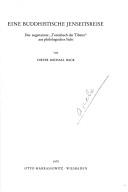
ISBN: 3447020628 Year: 1979 Publisher: Wiesbaden : Harrassowitz,
Abstract | Keywords | Export | Availability | Bookmark
 Loading...
Loading...Choose an application
- Reference Manager
- EndNote
- RefWorks (Direct export to RefWorks)
Buddhism --- Buddhist funeral rites and ceremonies --- Death --- Intermediate state --- Doctrines. --- Religious aspects --- Buddhism. --- Buddhism.
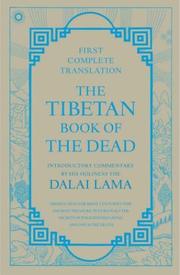

ISBN: 9780713994148 0713994142 Year: 2005 Publisher: London : Penguin books,
Abstract | Keywords | Export | Availability | Bookmark
 Loading...
Loading...Choose an application
- Reference Manager
- EndNote
- RefWorks (Direct export to RefWorks)
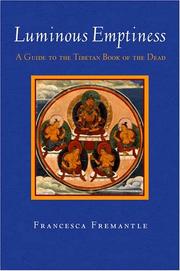
ISBN: 157062450X Year: 2001 Publisher: Boston (Mass.) : Shambhala,
Abstract | Keywords | Export | Availability | Bookmark
 Loading...
Loading...Choose an application
- Reference Manager
- EndNote
- RefWorks (Direct export to RefWorks)
The 'Tibetan Book of the Dead,' a best-seller for three decades, is one of the most widely read texts of Tibetan Buddhism. Over the years, it has been studied and cherished by Buddhists and non-Buddhists alike. 'Luminous Emptiness' is a detailed guide to this classic work, elucidating its mysterious concepts, terms, and imagery. Fremantle relates the symbolic world of the 'Tibetan Book of the Dead' to the experiences of everyday life, presenting the text not as a scripture for the dying, but as a guide for the living. According to the Buddhist view, nothing is permanent or fixed. The entire world of our experience is constantly appearing and disappearing at every moment. Using vivid and dramatic imagery, the 'Tibetan Book of the Dead' presents the notion that most of us are living in a dream that will continue from lifetime to lifetime until we truly awaken by becoming enlightened. Here, Fremantle, who worked closely with Chgyam Trungpa on the 1975 translation of the 'Tibetan Book of the Dead' (Shambhala), brings the expertise of a lifetime of study to rendering this intriguing classic more accessible and meaningful to the living. 'Luminous Emptiness' features in-depth explanations of: -The Tibetan Buddhist notions of death and rebirth -The meaning of the five energies and the five elements in Tibetan Buddhism -The mental and physical experience of dying, according to the Tibetan Buddhist tradition
Buddhist funeral rites and ceremonies. --- Death --- Funeral rites and ceremonies, Buddhist. --- Intermediate state --- Religious aspects --- Buddhism. --- Buddhism. --- Karma-gliṅ-pa,
Book
ISBN: 7561333641 9787561333648 Year: 2006 Publisher: [Xi'an] : Shanxi shi fan da xue chu ban she,
Abstract | Keywords | Export | Availability | Bookmark
 Loading...
Loading...Choose an application
- Reference Manager
- EndNote
- RefWorks (Direct export to RefWorks)
Buddhist funeral rites and ceremonies --- Buddhist funeral rites and ceremonies --- Death --- Intermediate state --- Reincarnation --- Tantric Buddhism --- Religious aspects --- Buddhism. --- Buddhism. --- Buddhism. --- Doctrines. --- Karma-gliṅ-pa,
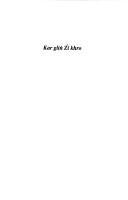
ISBN: 9073782856 Year: 1997 Publisher: Leiden : Research school CNWS,
Abstract | Keywords | Export | Availability | Bookmark
 Loading...
Loading...Choose an application
- Reference Manager
- EndNote
- RefWorks (Direct export to RefWorks)
294.3*93 --- Bonpo (Sect) --- Gods, Bonpo --- -Gods, Buddhist --- -Intermediate state --- -Tantric Buddhism --- Buddhism, Tantric --- Buddhist tantrism --- Esoteric Buddhism --- Mantrayāna Buddhism --- Mikkyō --- Tantrism, Buddhist --- Vajrayāna Buddhism --- Buddhism --- Mahayana Buddhism --- Death --- Eschatology --- Future life --- Heaven --- Hell --- Purgatory --- Soul --- Gods, Buddhist --- Gods, Lamaist --- Gods --- Bonism --- Religions --- Tantrisme. Vajrayana. Matrayana --- Religious aspects --- Bon (Tibetan religion) --- Buddhist gods --- Intermediate state --- Tantric Buddhism. --- Buddhism. --- 294.3*93 Tantrisme. Vajrayana. Matrayana --- Bon (Tibetan religion). --- Bonpo (Sect). --- Tantric Buddhism
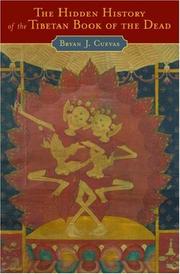
ISBN: 0195154134 9780195154139 Year: 2003 Publisher: New York (N.Y.): Oxford university press
Abstract | Keywords | Export | Availability | Bookmark
 Loading...
Loading...Choose an application
- Reference Manager
- EndNote
- RefWorks (Direct export to RefWorks)
In 1927, Oxford University Press published the first western-language translation of a collection of Tibetan funerary texts (the Great Liberation upon Hearing in the Bardo) under the title The Tibetan Book of the Dead. Since that time, the work has established a powerful hold on the western popular imagination, and is now considered a classic of spiritual literature. Over the years, The Tibetan Book of the Dead has inspired numerous commentaries, an illustrated edition, a play, a video series, and even an opera. Translators, scholars, and popular devotees of the book have claimed to explain its esoteric ideas and reveal its hidden meaning. Few, however, have uttered a word about its history. Bryan J. Cuevas seeks to fill this gap in our knowledge by offering the first comprehensive historical study of the Great Liberation upon Hearing in the Bardo, and by grounding it firmly in the context of Tibetan history and culture. He begins by discussing the many ways the texts have been understood (and misunderstood) by westerners, beginning with its first editor, the Oxford-educated anthropologist Walter Y. Evans-Wentz, and continuing through the present day. The remarkable fame of the book in the west, Cuevas argues, is strikingly disproportionate to how the original Tibetan texts were perceived in their own country. Cuevas tells the story of how The Tibetan Book of the Dead was compiled in Tibet, of the lives of those who preserved and transmitted it, and explores the history of the rituals through which the life of the dead is imagined in Tibetan society. This book provides not only a fascinating look at a popular and enduring spiritual work, but also a much-needed corrective to the proliferation of ahistorical scholarship surrounding The Tibetan Book of the Dead.
Intermediate state --- Death --- Buddhist funeral rites and ceremonies --- Buddhism --- Religious aspects --- Karma-gliṅ-pa, --- Criticism, Textual --- 294.3*94 --- -Funeral rites and ceremonies, Buddhist --- -Intermediate state --- -Death --- Eschatology --- Future life --- Heaven --- Hell --- Purgatory --- Soul --- Funeral rites and ceremonies, Buddhist --- Funeral rites and ceremonies, Lamaist --- Funeral rites and ceremonies --- Dying --- End of life --- Life --- Terminal care --- Terminally ill --- Thanatology --- Lamaïsme --- -Buddhism --- Rituals --- Philosophy --- Karma-glin-pa --- -Criticism, Textual --- Buddhism. --- Karma-gliṅ-pa, --- Criticism, Textual. --- -Lamaïsme --- 294.3*94 Lamaïsme --- -294.3*94 Lamaïsme --- Religious aspects&delete& --- Intermediate state - Buddhism --- Death - Religious aspects - Buddhism --- Buddhist funeral rites and ceremonies - China - Tibet Autonomous Region --- Karma-gliṅ-pa, - active 14th century - Bar do thos grol --- Karma-gliṅ-pa, - active 14th century - Bar do thos grol - Criticism, Textual
| Listing 1 - 10 of 25 | << page >> |
Sort by
|

 Search
Search Feedback
Feedback About UniCat
About UniCat  Help
Help News
News